Some people say that ngons should be avoided at all costs, while others say that this hatred and phobia of N-sided polygons needs to stop.
In this tutorial we’ll take an in-depth look at the problems with ngons to raise our 3d modeling game.
Blender 2.8 beta has been used for all demos.
What is an Ngon?
An ngon is simply a face with more than 4 edges.

There are modeling methods like boolean operations or software like computer-aided design (or CAD) that tend to output ngons in large numbers.
Ngons seem to have a bad reputation among 3d modelers. Well, that is a divisive topic and people feel strongly about the issue, some for it and some against it:
“Quad only is a stupid myth that serves no one.”
“NGons should never be present in a final model.”
“It is better to avoid Ngons altogether since quads and tris will always subdivide properly.”
“…This hatred and phobia of Ngons needs to stop.”
“Ngons as intelligent modeling strategy? No.”
In my opinion there is a certain bias towards the no-ngons modeling strategy. Let’s take a look at what is considered to be the disadvantages of using ngons in 3d modeling, then try to defend the opposite point of view.

Ngons Problems
1. Rendering (shading) issues
Ngons are associated with degraded surfaces that are supposed to be flat, but the shading or the curvature suggests that they aren’t. If all vertices of an ngon don’t lie in the same plane it can look really weird because it isn’t clear how to display such shape before it gets passed to render engine.

Ngons can be the cause of shading issues that ruin otherwise great boolean operations for aspiring 3d modelers.
It’s not easy to get over the initial frustration of seeing an after-boolean mesh. Why does it look so strange? What’s wrong with it? It must be ngons.

In addition to that, shading issues associated with ngons tarnish the boolean ops based workflow and we become suspicious of the entire workflow for that matter.
2. Limited use of subdivision surfaces
Ngons are claimed to not only look glitchy, but also result in all sorts of mesh editing problems. They disrupt the edge flow of your model and make standard modeling operations like extrusion less effective because we can’t use subdivision surfaces.
Unlike quads or triangles, ngons subdivide poorly in many cases, so it’s a potential showstopper for workflows that need subdivision surfaces for whatever purposes, car creation for example.

3. Awful looking wireframe
Chaotic-looking topology is another reason why ngons are frowned upon.

4. Deformation
Ngons often lead to animation (or more precisely, deformation) problems. Topology for animation relies on proper edge flow, and thus ngons are a big no-no if the mesh is supposed to be bent or deformed in any other way.

5. Interoperability
Ultimately, ngons behave in an unpredictable way when the mesh is imported/exported to game engines or to other modeling and sculpting applications (because some applications do not handle ngons well and there are always no guarantees about how exactly ngons will be interpreted, because there are no standards).

But all things considered, are ngons really that evil as we might have thought about it?
Before moving on let’s get down to basics and talk about triangulation.
3D Modeling Basics: Triangulation
On rendering, every ngon is subdivided into triangles or triangulated.
And so are quads. Quads are also split into triangles.

That’s how most render engines work, because triangles form the simplest closed area and thus are easy to rasterize and raytrace.
Under the hood, all shading and rendering calculations use triangles as basic units, even though it may seem that we, 3d modelers, work with quads or ngons.

So, every ngon gets split into triangles, but how exactly? For example there are five possibilities to split a pentagon into triangles and it gets even more complicated in case of higher ordered ngons. So ngon is always an implicit surface and different types of triangulation produce different looking results, some better than others.
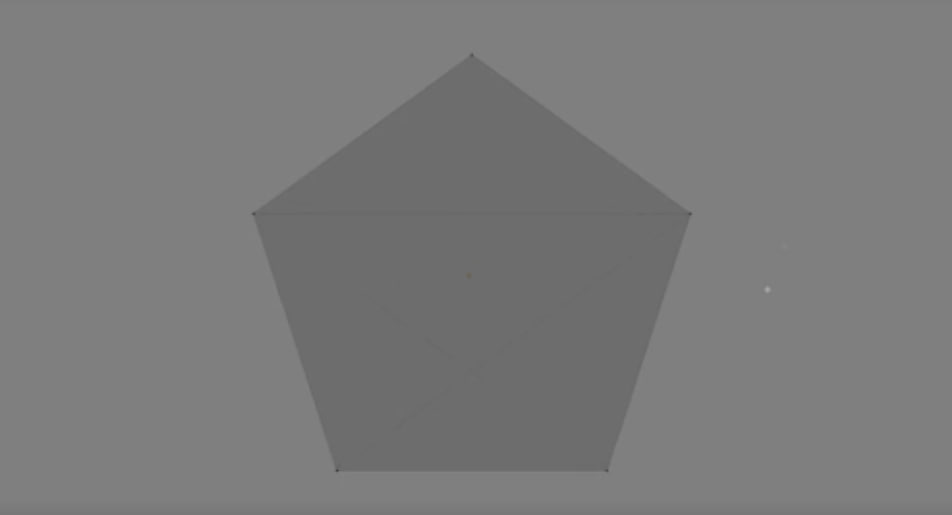
That’s a crucial thing to understand, because what we perceive as the inherent problem of ngons (bad shading) can partly be attributed to non optimal triangulation among other things.
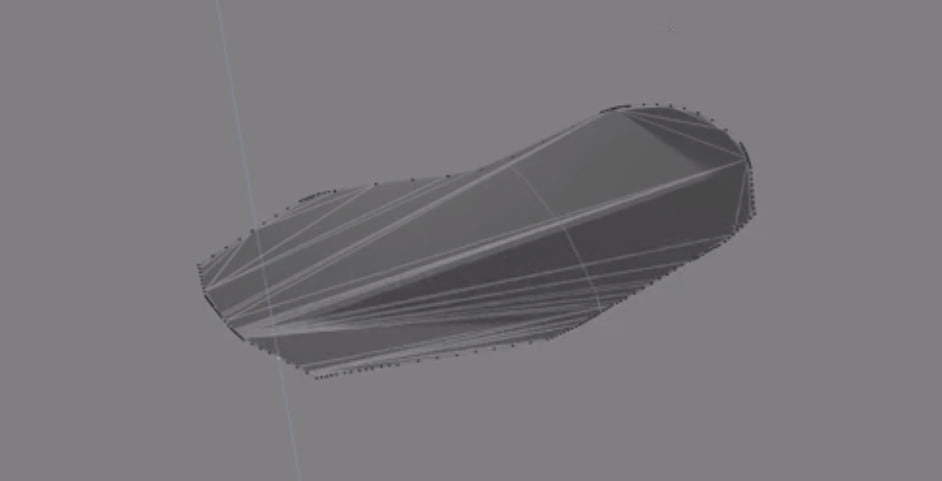
Now let’s go ahead and take a closer look at the disadvantages of using ngons.
Disadantages of Using Ngons – Closer Look
1. Rendering (shading) issues: Triangulation
So what do we actually mean when we say “a non optimal triangulation” and what is an optimal triangulation then?
There are different methods of triangulation. In Blender, we have the clip and beauty methods. Beauty arranges the new triangles evenly, while clip splits the polygons with so called ear clipping algorithm, that generally performs a bit faster but produces a noticeably worse set of triangles.


So just by changing the triangulation method we can get a more optimal triangulation and as a result, much better shading.
2. Rendering (shading) issues: non-planar surfaces
If a surface should be perfectly flat by design, let’s just make sure it is flat (for example, by using the flatten command in the Loop Tools Addon amongst other methods). By the way, perfectly flat surfaces with sharp hard-surface connections are an ideal case for using ngons, as they always shade in a proper way. Curved surfaces are a different story, we will talk about it shortly.

3. Rendering (shading) issues: smoothing
As for smooth shading errors in relation to ngons, controlling smooth shading by marking edges sharp often does the trick. Marking edges sharp means telling 3d modeling application to stop trying to smooth out the connection between two surfaces based on their normals.


Taking control of smoothing, e.g. marking edges sharp manually or paying attention to auto smooth angle turns out to be liberating in terms of what modeling styles can be used. Together with the bevel modifier it opens up boolean operations because now we can sharpen some edges and still get a gradual transition from one surface to the other (with the help of the bevel modifier). This workaround unleashes enormous creative potential.

4. Shading issues: bad topology
The source of rendering glitches can be sloppy topology in general (like, not having enough polygons to support some mesh editing operations or having an uneven distribution of polygons).


Another defining characteristic of all kinds of bad topology issues is poles. To explain that, let’s revisit topology basics once again.
3D Modeling Basics: N-Poles
A pole is when 3 or more edges converge at a single vertex.
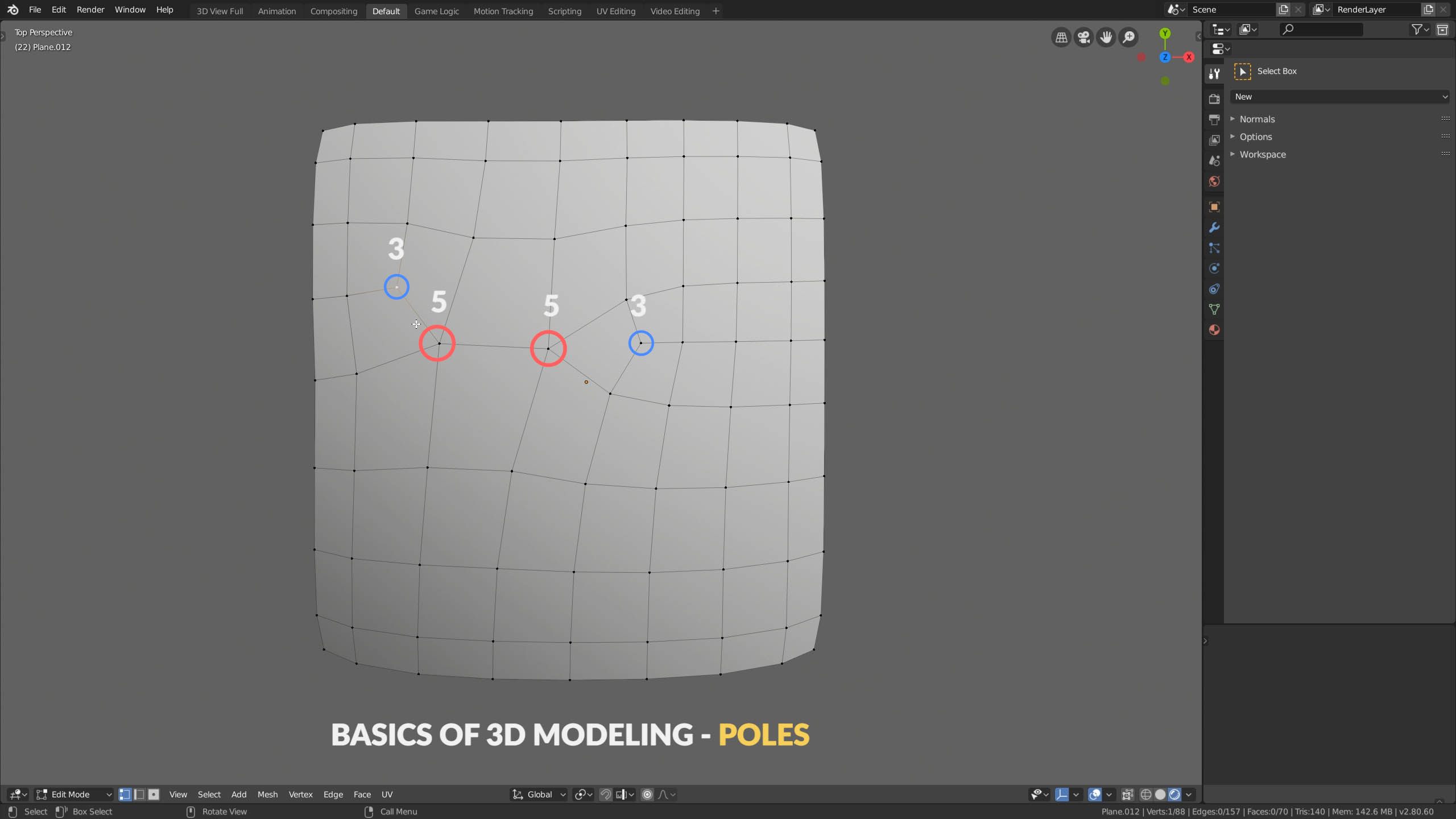
Sometimes 3 and 5 poles are called N or E poles respectively, though we prefer using the number in the name as it’s easier to remember since the number of edges coming to a point defines the pole. 3 edges come to a point for the 3 pole, 5 edges for the 5 pole, 6 edges for a 6 pole etc.
So why do we have those poles in a quad filled mesh? Because without those poles we can’t effectively have the topology flow to match the 3d shape of whatever it is that we’re trying to create. So we just try our best to place those poles in sensible places.
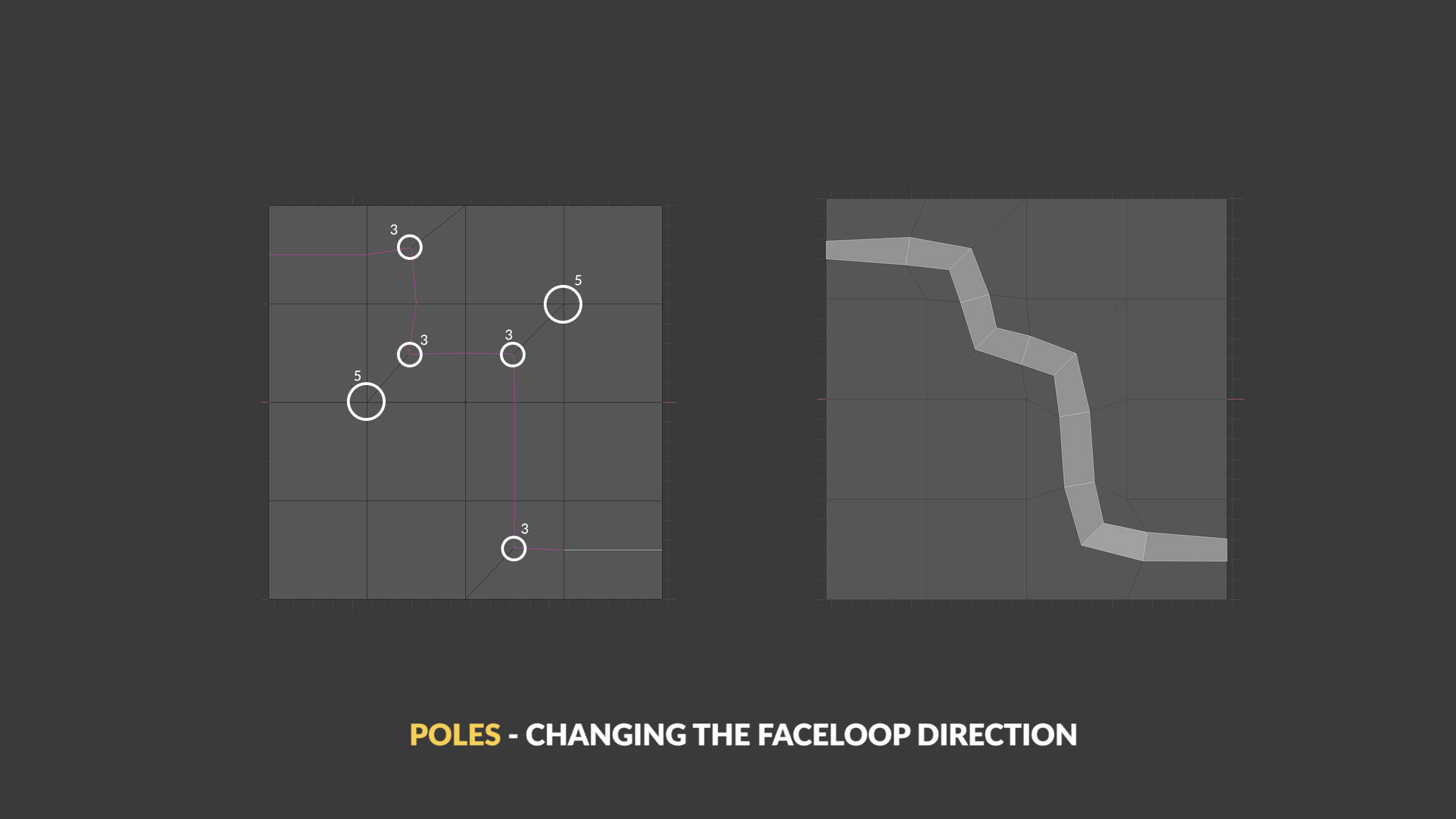
So why are poles noteworthy?
- This is where our edge loop selection or creation gets terminated
- No matter how much we subdivide the mesh our poles won’t change
- These areas can shade not as smoothly and predictably as a uniformly grid like mesh with no poles


If like in Scooby Doo we were to unmask the real villain we would finally locate and unmask the ngon and find a 3 pole or 5 pole or more underneath complaining they would have ruined the shading on our mesh and would have gotten away with it too (if it wasn’t for those meddling kids).
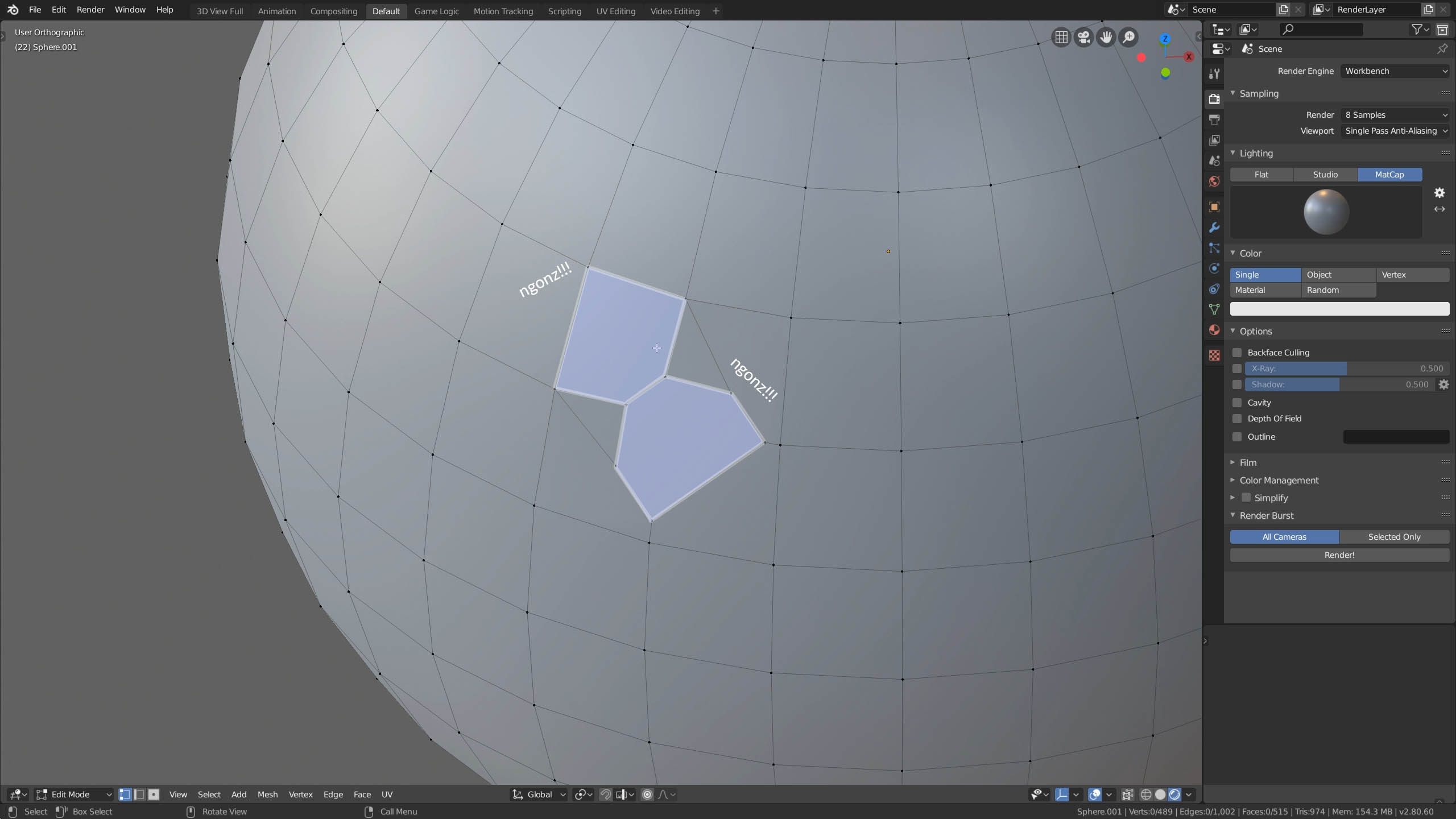
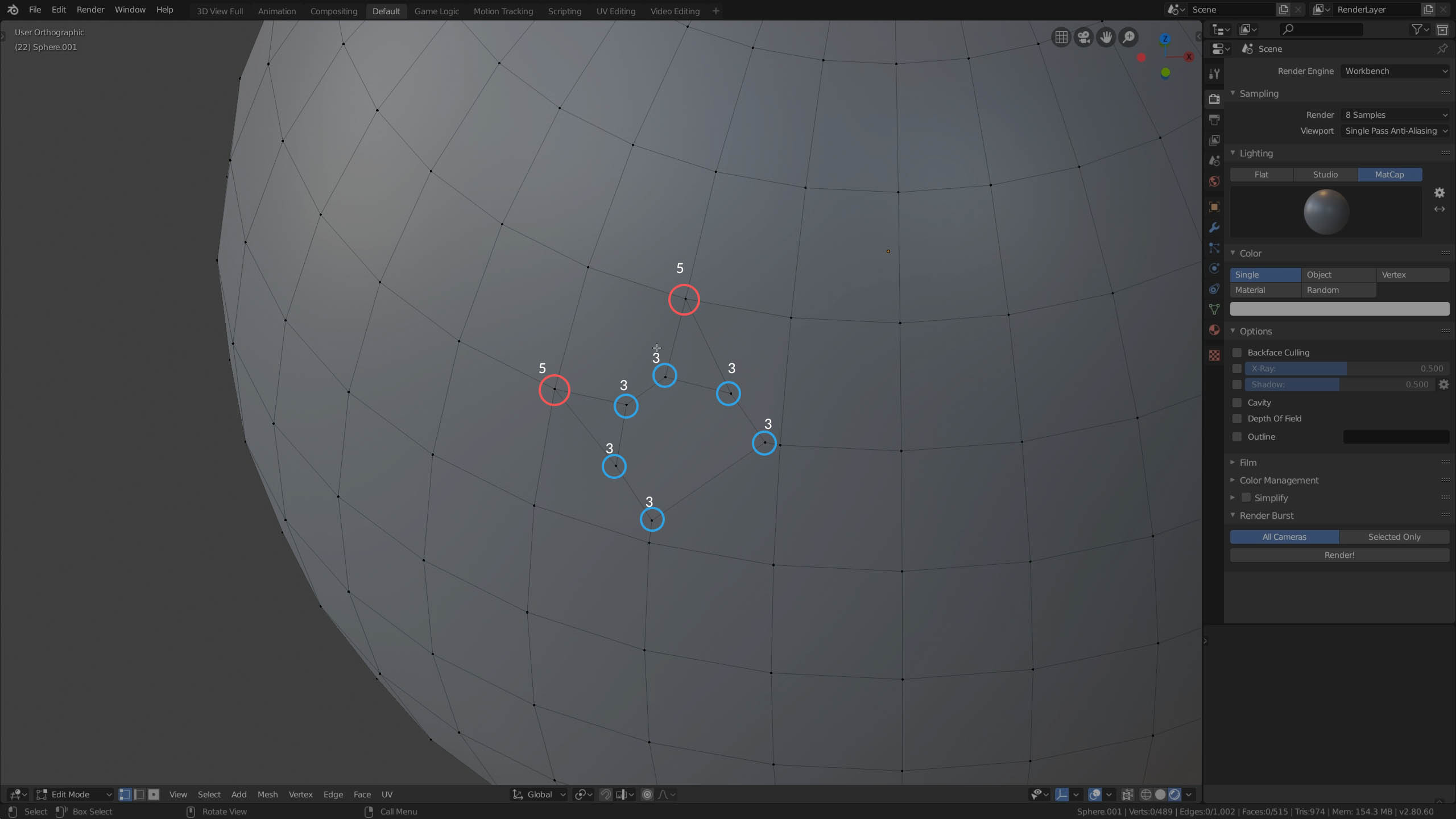
5. Displacement
The other case in which we may want to work with quadrilaterals and avoid poles is displacement.

So why do ngons and triangles get so much criticism? It’s because that’s where we are guaranteeing the creation of a pole and therefore issues of shading under certain deformation and where the selection of an edge loop or creation of an edge loop will terminate.
6. Limited use of subdivision surfaces.
Because subdivision algorithms like Catmull-Clark used in Blender, 3ds max, Zbrush and other 3d modeling apps requires strict rules for mesh topology (that means having good edge flow and using mostly quads and having no poles), ngons don’t work well with subdivision. I would say, mainly because of long thin triangles and also poles which lead to pinching and other modeling issues from hell.


That’s a shame, because subdivision surfaces are great for approximating curved meshes, so not being able to use from start to end it makes it a lot harder to model smooth flowing surfaces.
In practice, that means that after we start carving boolean shapes and all that stuff, the only way to reestablish good edge flow would be retopology. I think it’s a decent tradeoff for using boolean ops which are amazing for mechanical design though.


On the other hand, some shapes are easier modeled without subdivision and without all-quads for that matter.

7. Beveled edges
The curved or beveled edges that we lose by waiving the subsurf modifier can be created with the bevel modifier instead. It works perfectly fine with ngons and helps us to achieve these sexy bevels with proper smooth shading.
In that sense ngons are much more appropriate for hard-surface modeling rather than automotive, organic or, god forbid, character modeling. Conversely, quadrilateral geometry could be better suited for organic, automotive and character modeling.
8. Awful looking wireframe
That’s… arguable. In fact, in many cases ngons make for much more elegant wireframe (especially if we don’t show a triangulated version). By collapsing the edges that don’t follow the contours of the surface we make it more, not less, readable in my opinion.
In addition to that, one notable advantage of using ngons is having less polygons overall. As a rule of thumb, boolean meshes and other kinds of meshes with ngons require less polygons to describe the surface area than the meshes, originated from subdivision surfaces.


9. Deformation
Deformation is a pretty serious problem of ngons.

Although, with enough geometry and more or less uniform polygonal density meshes with ngons can bend reasonably well, but not perfect by any means. So if you know that the mesh isn’t going to be deformed, then it’s ok. If it is going to be deformed, proceed with caution.

Again, following good modeling practices like having enough polygons is always helpful, no matter whether it’s 4-sided polygons or n-sided polygons.

10. Interoperability
Unfortunately there are no guarantees that ngons will import/export as expected because often times 3d applications make arbitrary decisions on how ngons should be triangulated. Once ready to export, it’s worth double-checking what triangulation algorithm you’d like to use.


Conclusion
The key takeaway is that ngons are neither universally good or bad, it depends on what modeling goal you want to achieve.

In conclusion, there are numerous disadvantages of using ngons, but some of their disadvantages are continuation of their merits and can be ignored in favor of 3d modeling possibilities you get in exchange. And they do have pros such as:
- Less polygons overall
- Elegant wireframe (arguably)
- Boolean operations unlocked
- Bevel modifier
- Quick concepting
I would say, the real arguments against ngons are bad deformation and interoperability, these are just bad things.
Also I’ve heard that ngons make it really tough to get good uv maps. And probably, physics engine operations on ngons could be problematic.
In my opinion, the other issues discussed in this video can be mitigated or even framed positively.
A Few Practical Takeaways:
Curved and going to be deformed = quads. Flat and not going to be deformed = ngons.


Pay attention to smooth shading settings, what surfaces should be marked as sharp, what’s the auto smooth angle and so on.

If it’s going to be exported to game engine or to application that doesn’t handle ngons well, triangulate it first to reduce the chances of incorrect triangulation.

Watch out for poles!

Ngons or quads, having enough polygons to allow deformation (and an even distribution of polygons for that matter) is always a good practice.

Lastly, when working with ngons, retopology may be required.

On a side note, there are numerous ways of masking the shading artifacts with the help of the data transfer modifier, shrinkwrap modifier and so on.
Links:
Hard-surface Modeling in Blender (Blender Market)
Hard-surface Modeling in Blender (Gumroad)
Master Car Creation in Blender
Khan Academy Pixar SubD Explained
Over to You
Embracing polygons with more than four edges will open up a wonderful world of boolean operations for you, especially if you’re interested in hard-surface modeling. If not for production, then at least for concepting. Let us know in the comments below, do you use ngons in your modeling?



Pingback: Resources for Beginner 3D Artists – Erika Moya
Pingback: 遊戲設計 進修日記 – Blender – 19 | 店小二日記
Pingback: Make Money With Video Games (3D Modelling) – thedorkdome-com.preview-domain.com